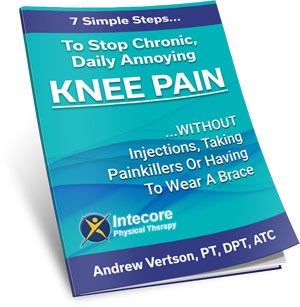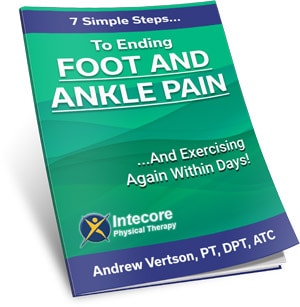
If you’ve been dealing with nagging pain or a long-term injury, it’s easy to feel like surgery is the only solution. You might even have a referral in hand or a date circled on the calendar.
But here’s something I share with nearly every patient who walks into our clinic: surgery is not always your only option.
In fact, for many common injuries and conditions, physical therapy (PT) can be an effective, non-invasive alternative to going under the knife.
Before you commit to surgery, it’s worth asking yourself:
Have I given physical therapy a real shot?
Table of Contents
How Does Physical Therapy Work to Prevent Surgery?
Think of physical therapy as training your body to heal the right way with movement, strength, and smart guidance.
At Intecore PT, we start by looking at how you move, what muscles are compensating, and what’s causing your pain. Then we build a personalized plan to correct those imbalances, which can sometimes help you to avoid the need for surgical intervention entirely.
Some of the key techniques we use include:
- Manual therapy to improve joint mobility and reduce muscle tightness
- Targeted strengthening to stabilize areas like knees, shoulders, hips, and the spine
- Neuromuscular re-education to retrain how your body moves
- Mobility exercises to improve range of motion
- Pain-relieving modalities
What’s powerful about PT is that we don’t just treat symptoms, we go after the root cause. And that’s why it works so well for helping people avoid surgery.
What Conditions Can PT Help With Instead of Surgery?
There are so many conditions where PT is not only effective but recommended as a first-line treatment before surgery.
Here’s a breakdown of common cases:
| Condition | When PT Might Help You Avoid Surgery |
|---|---|
| Rotator cuff tears | Partial tears and impingements often improve with strength and mobility work. |
| Meniscus tears | Especially in older adults, many tears heal with PT instead of arthroscopic surgery. |
| Herniated discs | PT can relieve nerve pressure and reduce symptoms without needing spinal surgery. |
| Knee osteoarthritis | Strengthening the muscles around the knee reduces pain and often delays or prevents knee replacements. |
| Low back pain | Research shows PT is more effective than surgery for most non-emergency back pain cases. |
The American Physical Therapy Association (APTA) recommends physical therapy (PT) as a first-line treatment for many musculoskeletal issues, often before considering surgery.
Why Do So Many People Skip Physical Therapy and Go Straight to Surgery?
Unfortunately, many people never get referred to physical therapy or they assume surgery is their only option.
Here are some common reasons people go straight to surgery:
- They’re looking for a quick fix: Surgery can seem like a faster solution, but recovery often takes months. PT, though gradual, can produce long-term change with fewer risks.
- They don’t realize PT is an option: Unless your physician recommends it, you may not know how effective PT can be.
- They believe surgery is more “permanent”: But surgical outcomes are not always guaranteed. And if the root problem isn’t addressed, the pain can return even after surgery.
- They’re overwhelmed by pain: We get it, when you’re in pain, you want relief. But pain relief doesn’t always require an operating room.
In reality, physical therapy can be a safer, more cost-effective path for many people. And it comes with fewer complications, less downtime, and better long-term outcomes.
When Is Surgery Actually the Right Call?
Sometimes, surgery is the best option.
Here are a few situations where surgery might be necessary:
- Complete tendon or ligament ruptures, like a full ACL tear
- Advanced joint damage, where conservative care no longer helps
- Spinal issues with loss of bowel/bladder control or progressive weakness
- Fractures that won’t heal without surgical stabilization
But even in these cases, pre-surgical PT (“pre-hab”) can improve surgical outcomes, and post-op rehab is critical to full recovery. PT helps restore range of motion, rebuild strength, and reduce pain after surgery – so it’s still a vital part of the process.
What’s the First Step?
If you’ve been told surgery might be your only option, take a breath. You may have more choices than you think.
Start by getting a thorough evaluation from a physical therapist. We’ll help you understand what’s going on in your body, what options are available, and whether PT could help you avoid surgery altogether.
And if you’ve already had imaging or a diagnosis, bring it in, we’ll build a plan around it.
Take the Next Step With Us
Surgery is sometimes necessary, but if you’d like us to see if there’s another solution, we’re here to help.
If you’re dealing with pain, limited movement, or recovering from an injury, you don’t need to suffer in silence or rush into surgery.
Click here to schedule a consultation or give us a call at: 949 597-2103
Let’s get you back to doing what you love!
FAQ:
Can physical therapy really prevent surgery?
Yes! For many injuries, especially involving joints and the spine, PT can relieve pain and restore function—making surgery unnecessary.
What kinds of injuries respond well to PT instead of surgery?
Rotator cuff issues, meniscus tears, herniated discs, arthritis, and back pain are all commonly treated successfully with PT
Is it better to try PT before surgery?
Absolutely. It’s non-invasive, lower risk, and often just as effective. Many medical guidelines recommend trying PT before surgical intervention.
How long should I try PT before considering surgery?
How long should I try PT before considering surgery?
In most cases, you should give PT 4–6 weeks of consistent effort. If you’re not seeing improvement by then, your therapist can guide you on next steps.
- What Is Gout? Why It Happens and What You Can Do About It - November 17, 2025
- 3 Essential Back-Saving Tips You MUST Know Before Any Workout - November 14, 2025
- Are You Experiencing Shoulder Pain from Sleeping Wrong? - October 21, 2025













